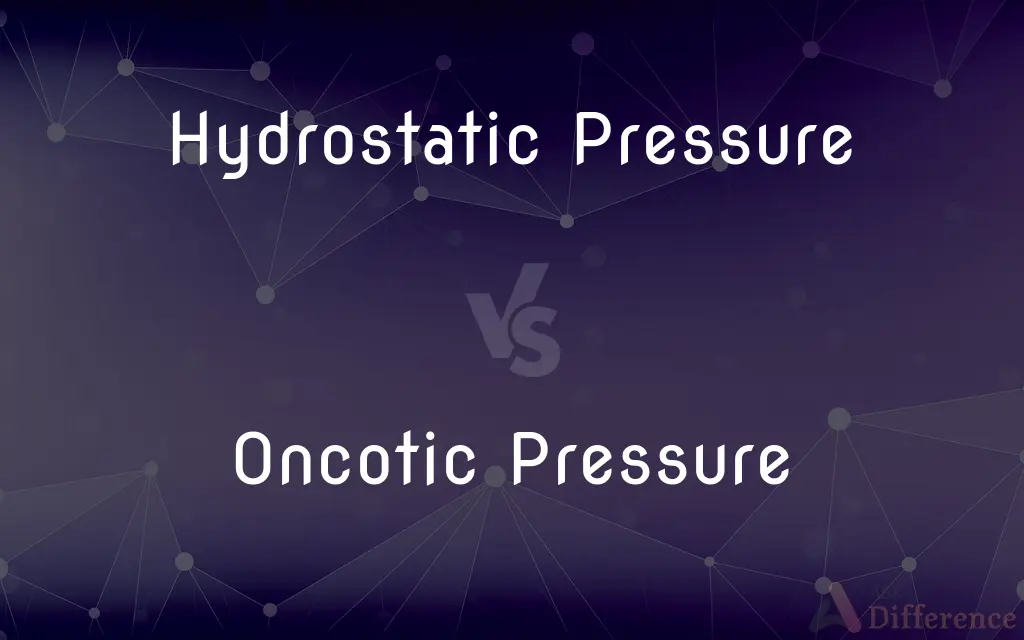Hydrostatic Pressure vs. Oncotic Pressure — What's the Difference?
Edited by Tayyaba Rehman — By Fiza Rafique — Published on December 1, 2023
Hydrostatic Pressure is the force exerted by fluids; Oncotic Pressure is the osmotic pressure due to proteins.

Difference Between Hydrostatic Pressure and Oncotic Pressure
Table of Contents
ADVERTISEMENT
Key Differences
Hydrostatic Pressure refers to the force exerted by a fluid against a surface, whereas Oncotic Pressure is a type of osmotic pressure exerted by large molecules, particularly proteins in blood plasma. Hydrostatic Pressure acts to push fluid out of blood vessels and into the surrounding tissue spaces. On the contrary, Oncotic Pressure tends to pull fluid back into the vessels from the surrounding tissue spaces.
In the circulatory system, Hydrostatic Pressure is often a result of blood pressure created by the pumping action of the heart. This pressure forces fluid, or plasma, out of the capillaries and into the surrounding tissues. On the other hand, Oncotic Pressure plays a vital role in the reabsorption of this fluid. The proteins in the blood plasma create a gradient that pulls fluid back into the capillaries.
Hydrostatic Pressure is important in various processes, including filtration in the kidneys. When this pressure is too high, it may lead to conditions like hypertension. On the opposite end, Oncotic Pressure ensures that there is a balance in fluid movement, preventing excessive fluid loss from the capillaries. When Oncotic Pressure is compromised, it can result in edema or swelling in the tissues.
The balance between Hydrostatic Pressure and Oncotic Pressure is essential for maintaining fluid homeostasis in the body. While Hydrostatic Pressure pushes fluids out, Oncotic Pressure works against it, ensuring that fluid levels inside and outside the blood vessels are regulated. Both pressures are crucial for the proper functioning of the circulatory system and overall health.
To summarize, Hydrostatic Pressure deals with the force exerted by fluids on surfaces, especially in blood vessels. In contrast, Oncotic Pressure is all about the osmotic influence of large molecules, primarily proteins, in pulling fluid back into the vessels. Both these pressures work in tandem to maintain fluid balance in the body.
ADVERTISEMENT
Comparison Chart
Definition
Force exerted by a fluid.
Osmotic pressure due to proteins.
Primary Influence
Blood pressure and fluid volume.
Concentration of proteins in plasma.
Role in Blood Vessels
Pushes fluid out of vessels.
Pulls fluid into vessels.
Impact on Health
High levels can cause hypertension.
Low levels can lead to edema.
Relation with Filtration
Facilitates filtration in the kidneys.
Balances reabsorption in capillaries.
Compare with Definitions
Hydrostatic Pressure
Pressure in a fluid at rest.
The Hydrostatic Pressure at the bottom of the tank increased with depth.
Oncotic Pressure
Counter to hydrostatic push in vessels.
The balance between Hydrostatic Pressure and Oncotic Pressure keeps fluid homeostasis.
Hydrostatic Pressure
Fluid pressure against surfaces.
Due to Hydrostatic Pressure, deep-sea divers require specialized equipment.
Oncotic Pressure
Osmotic force due to plasma proteins.
Low Oncotic Pressure can lead to fluid buildup in tissues.
Hydrostatic Pressure
The force exerted by standing fluid.
Water in a dam exerts Hydrostatic Pressure on its walls.
Oncotic Pressure
Result of protein concentration gradient.
High protein levels in the blood increase Oncotic Pressure.
Hydrostatic Pressure
Fluid's force resisting external force.
In the pipe, Hydrostatic Pressure prevented water from leaking.
Oncotic Pressure
Pulling force in blood vessels.
Oncotic Pressure ensures fluid reenters the capillaries.
Hydrostatic Pressure
Resultant force of fluid molecules.
The Hydrostatic Pressure in the syringe increased as it was filled.
Oncotic Pressure
Balancer of fluid movement in capillaries.
Without adequate Oncotic Pressure, tissues might swell.
Common Curiosities
What role does Oncotic Pressure play in the blood vessels?
Oncotic Pressure helps in pulling fluids back into blood vessels, preventing dehydration of tissues.
Why is Hydrostatic Pressure important?
It's crucial for processes like fluid movement and filtration in organs like the kidneys.
What is Hydrostatic Pressure?
Hydrostatic Pressure is the force exerted by a fluid at rest, typically due to gravity.
How is Hydrostatic Pressure different from Oncotic Pressure?
Hydrostatic Pressure is the force exerted by fluids, while Oncotic Pressure is the osmotic force due to plasma proteins.
Can imbalances in Hydrostatic Pressure be harmful?
Yes, high Hydrostatic Pressure can lead to conditions like hypertension.
How does a decrease in Oncotic Pressure affect the body?
A decrease can result in edema or swelling due to fluid accumulation in tissues.
How is the balance between Hydrostatic Pressure and Oncotic Pressure maintained?
The body maintains this balance to ensure fluid homeostasis in and out of blood vessels.
Can Hydrostatic Pressure vary in different parts of the body?
Yes, for example, it's higher in the lower extremities due to gravity.
Is Oncotic Pressure always constant?
No, it can change based on factors like protein levels in the blood.
How does Hydrostatic Pressure affect the kidneys?
It facilitates filtration by pushing fluids through kidney structures.
Why are proteins essential for Oncotic Pressure?
Proteins in plasma create a concentration gradient essential for Oncotic Pressure.
How does liver disease impact Oncotic Pressure?
It can decrease protein synthesis, leading to reduced Oncotic Pressure.
How can one measure Hydrostatic Pressure?
It's often inferred from measurements of fluid heights, like in a mercury barometer.
What happens if Hydrostatic Pressure exceeds Oncotic Pressure in blood vessels?
It can result in excessive fluid moving out of the vessels into surrounding tissues.
What clinical conditions can affect Oncotic Pressure?
Conditions like malnutrition, kidney diseases, and liver diseases can alter Oncotic Pressure.
Share Your Discovery

Previous Comparison
Method Overloading in Java vs. Method Overriding in Java
Next Comparison
Perception vs. ConceptionAuthor Spotlight
Written by
Fiza RafiqueFiza Rafique is a skilled content writer at AskDifference.com, where she meticulously refines and enhances written pieces. Drawing from her vast editorial expertise, Fiza ensures clarity, accuracy, and precision in every article. Passionate about language, she continually seeks to elevate the quality of content for readers worldwide.
Edited by
Tayyaba RehmanTayyaba Rehman is a distinguished writer, currently serving as a primary contributor to askdifference.com. As a researcher in semantics and etymology, Tayyaba's passion for the complexity of languages and their distinctions has found a perfect home on the platform. Tayyaba delves into the intricacies of language, distinguishing between commonly confused words and phrases, thereby providing clarity for readers worldwide.













































